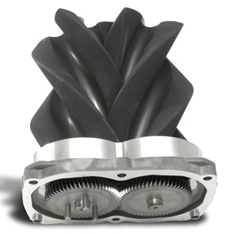
MARSHALL, MI – Jake Hooks moved up to president of Eaton Corp.’s Vehicle Group in 2009 during the deepest stage of the U.S. automotive recession, not exactly the way to start a new job.
Still, the Cleveland-based company weathered the downturn in better shape than most other suppliers, and during this year’s second quarter its overall revenues rose 16%.
Hooks’ group, which accounts for about 30% of Eaton’s total sales (the remainder includes electrical, hydraulics and aerospace), did even better with a 44% gain during the quarter while global auto production rose 31%.
In a Ward’s interview during a recent media event at Eaton’s proving grounds here, Hooks says Eaton’s car and truck business has fared relatively well because “we structured the business for the size it has become.”
With 55% of its revenues derived outside the U.S., Hooks says the group had a cushion of sorts, and customer diversity in the U.S. eased the potential pain. “It also helped that we had financial strength, and we’re now seeing a pretty steady book of business.”
Despite their cash crunch, Detroit’s three auto makers have paid their bills on time, he says.

Relations with the U.S. OEMs also are improving, he points out. “This is always going to be a demanding business. But if they want your technology, they’ll work closely with you to get it.”
Eaton’s Vehicle Group is a major supplier of valvetrains, superchargers, fluid connectors and plastics, as well as controls for powertrain, traction and emissions applications.
Technology is the key to its success in winning contracts globally, he says. But despite talk of widespread pirating of supplier technology, Hooks says Eaton has seen little evidence. “If you rely on technology, you’ve got to protect your patents, and we work hard on that,” he says.
Global engine downsizing seemingly could reduce demand for Eaton’s bread-and-butter components, such as valves.
But with overall global demand growing – Eaton projects light-vehicle production will rise 60% by 2015 to 90 million vehicles, with developing markets soaring to a 50% share – it is beefing up its valves to handle the stress of high-revving smaller engines.

Long a leader in performance-enhancing superchargers in 6- and 8-cyl. engines, Eaton until now has ceded the market for smaller engines to turbochargers.
That’s changing, as Eaton superchargers are appearing in Nissan Motor Co. Ltd.’s ’11 1.3L 3-cyl. Micra city car, as well as China’s Chery Automobile Co. Ltd. engines ranging in displacement from 1.3L to 1.6L.
The result in these city cars is more power and reduced emissions, Hooks says. Superchargers also eliminate so-called “turbo lag” during initial acceleration.
In another novel approach, Volkswagen AG’s 1.4L 4-cyl. “Twincharger” engine available in Europe combines both a turbocharger and supercharger.
“We’re also working with a major (unnamed) company to apply the supercharger technology to a direct-injected diesel to improve fuel economy and lower emissions, especially at first acceleration,” Hooks says.
Eaton, a longtime developer of cylinder-deactivation systems, also is introducing a new variable valvetrain technology to improve fuel economy up to 7% in high-revving overhead camshaft engines. Numerous auto makers worldwide will employ the technology in the coming three years, Hooks says.
“We will still supply components for small engines used in hybrid vehicles,” Hooks says. But Eaton’s main thrust in hybrids is development of a fuel-vapor management system to enhance safety and meet tough emissions regulations.
It also has developed electric-vehicle charging stations, recently teaming with Murphy Oil USA, which operates 1,000 discount gas stations, mainly at Walmart Supercenters.



